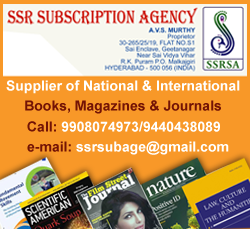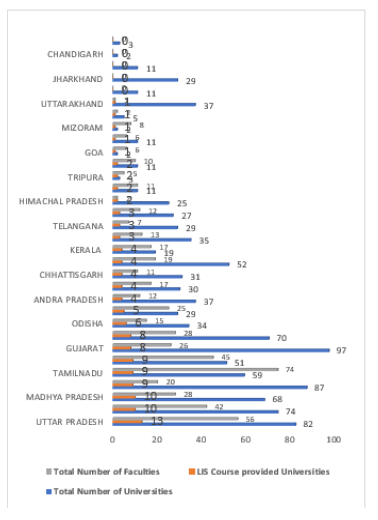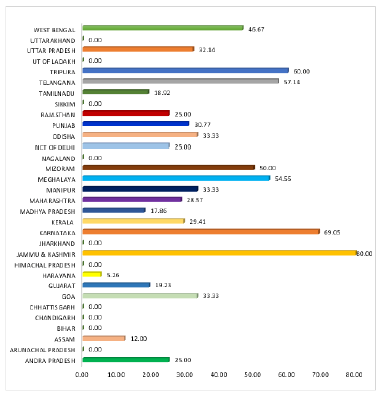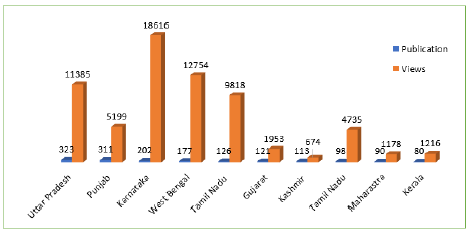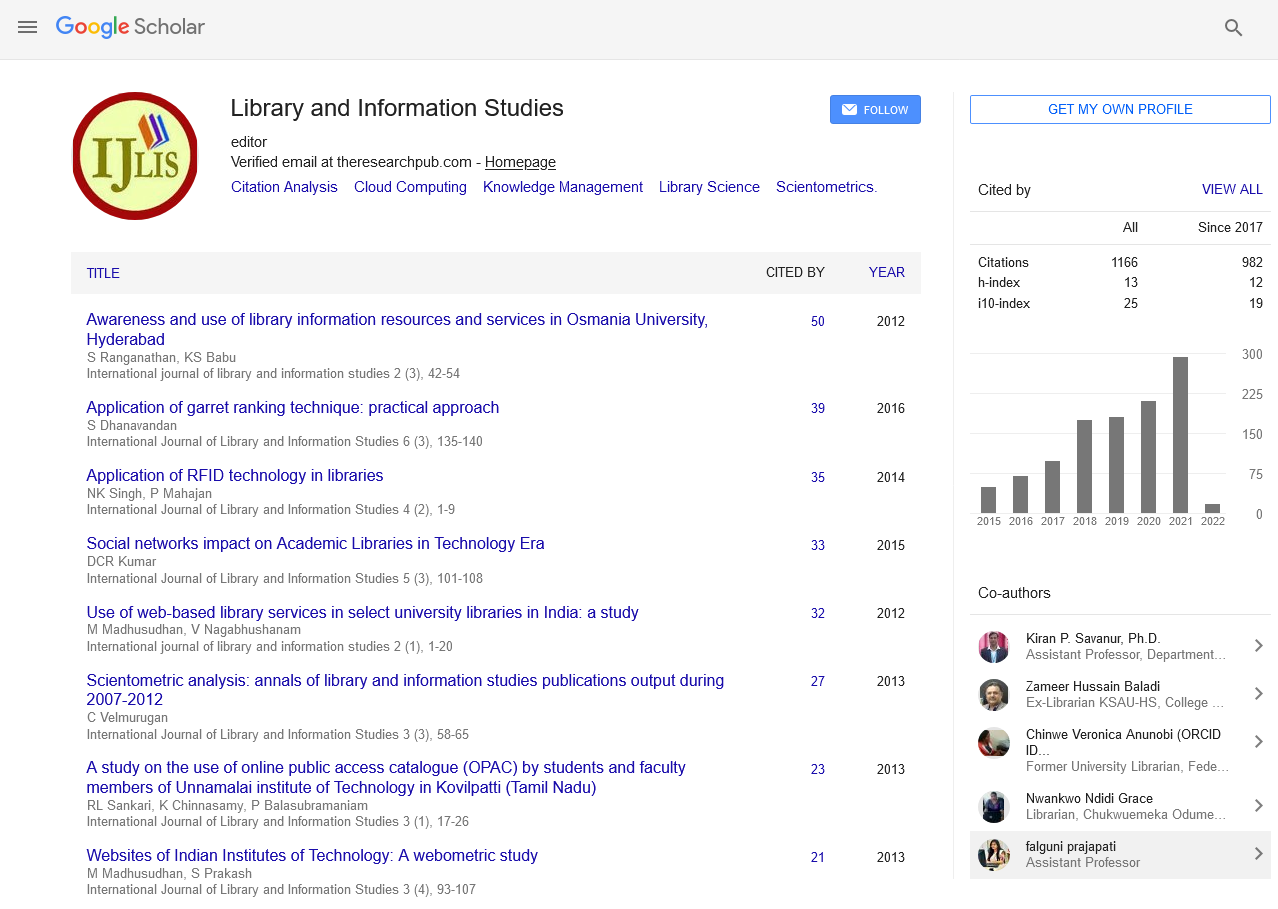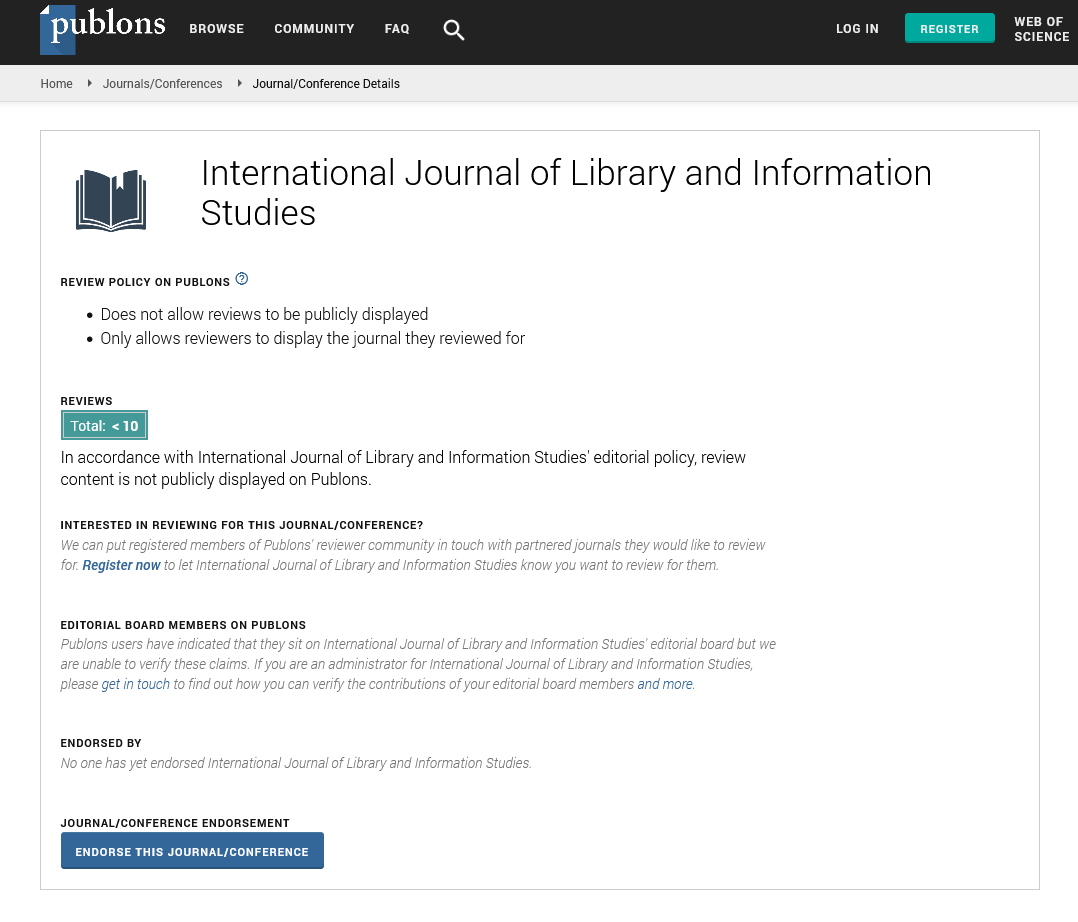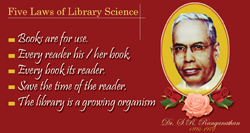Research Article - (2025) Volume 15, Issue 1
Indian LIS Faculty on ResearchGate: A Quantitative Assessment of Participation and Contribution
Mahalakshmi K R1*, Vinay M S2, Mohan Kumar J3 and Meghashree M4Abstract
The study examines academics participation and contribution on Academic Social Networks (ASNs) by the India's Library and Information Science (LIS) faculties, with a special focus on ResearchGate. Study depicts how faculty data is stored and focuses on schools that grant LIS degrees. Information was gathered from their profiles, including publications, reads, views, citations, impact points, RGScore, follows and people they follow the faculties account of total publications, reads, views, citations, impact points, RGScore, were collected. Statistical software tool SPSS 21 was used to run Pearson collection was used to analyze if their exist correlation between reads, publications citations and RG Score. The study results show that state of Uttar Pradesh has the most universities, out of 82 universities, 13 universities had 56 faculty members provide LIS programmes. There are 42 faculty members spread across 11 universities in Karnataka. Notably, Karnataka (69.05%) and Jammu & Kashmir (80%) are the highest ResearchGate account users. Punjab is second in terms of publications with 311 publications and 5199 views, after Uttar Pradesh with 323 articles and 11,385 views. From the state of Karnataka 202 papers receive the greatest number of views (18,616). ResearchGate may have an impact on the community's diffusion of knowledge about academic subjects, as evidenced by the statistics, which shows a strong correlation between the number of publications, views, and citations. There is a strong relationship between the number of publications and citations (R2=0.578, p<0.01), hence more the number of publications, a greater chance that the article gets cited. Also, higher the number of the article is read in ResearchGate the higher the chances of it receiving citations (r=0.750, p<0.01).
Keywords
Academic Social Networks, ResearchGate, Research dissemination, Scholarly communication, Citations
Introduction
ASNs have grown in popularity as a means for academics and researchers to network with other subject matter experts and to share their research. Additionally, they have developed into a means for academics to demonstrate the influence of their work by displaying the quantity of views downloads, followers and in the case of ResearchGate, their own scores (RG scores). ASNs are similar to Social Networking Sites (SNSs) with the exception that they are specifically designed to meet the needs of staff and faculty. Millions of people utilize academic social networks like Academia.edu, ResearchGate, Mendeley and Zotero, according to the surveys. ResearchGate was named the most renowned academic social media network by Nature in a 2014 survey that included opinions from 3,500 experts in 95 countries. Faculty researchers began investigating these sites to expand their research networks and international collaborations since they provide a number of advantages [1].
Faculties, Scholars and Research Community frequently utilize ASNs for a variety of activities, including creating accounts, posting articles, and working with colleagues. The study employed a quantitative research design, 120 percipients were chosen from the sample universities using a purposive sampling technique. The study examines the group of academics who use three social network site metrics. The collected data were analyzed using linear regression analysis and Pearson product-moment correlation, results showed that there was a favorable and significant correlation between lecturers' professional progress and Google Scholar, ResearchGate, and Academia.edu. A preliminary investigation carried out on the subject by selecting users of Academia.edu who are connected to twelve universities in Catalonia. 293 people answered a survey that was given to those whose profiles included email addresses. Using the site for a variety of purposes, participants indicated their main motivations, which were "to follow similar researchers' activities" (59%), "to connect with other researchers" (67%), and "to disseminate research output" (61%). Investigation, which was previously covered in the Open Access subject, included a survey with forty-three participants and ten semi-structured interviews. Participants in the study were asked to indicate which claims about their use of Academic Social Networks (ASNs) they agreed with. Interestingly, the strongest agreements were linked to increased publication citation and distribution, which is consistent with previous research findings. In contrast, interviewees disagreed the most on tracking metrics, even if they thought they were important. Study highlighted the specific ASNs, Academia.edu and RG. Researchers use ASNs primarily for information consumption, very little for social interaction and very little for information sharing. They visit ASNS for self-promotion, ego bolstering, professional knowledge acquisition, peer community belonging, and peer interaction. Recently academic social networks gaining more popularity among scholars and faculty. A variety of Academic Social Networks (ASNs) platforms, comprising Academia.edu, ResearchGate and Google Scholar my citation has gained more vogue from last few. In addition to that, ASNs can also provide measure of academic impact. Researcher came to conclusion that the scholars usually have a several networking accounts leads to difficult to manage and time consuming also, author recommended that researchers to strategically select the ASNS that meets his/her goals and hope that our work helps with that task. A wide range of research methodologies have adopted in LIS Profession. In attempt to understand the concept in better way [2,3].
Need for the study
The need for this study arises from the desire to gain a comprehensive understanding of the academic social networks participation among Library and Information Science (LIS) faculties across India, with a specific emphasis on ResearchGate. This study intends to provide significant insights into the landscape of academic research dissemination and its implications for research visibility, collaboration and impact within the LIS community in India. It also underscores the importance of continued research in understanding the dynamics of digital platforms in shaping scholarly communication and knowledge dissemination processes.
Materials and Methods
Research objectives
- To identify the status of Indian LIS faculty participation on ResearchGate
- To Assess Indian LIS faculty Scholarly Articles Presences in Research
- To identify the Top 10 States with Highest ResearchGate Publications and views
- To assess the correlation between total publication and the number of citations
Research methodology
The focus for the current study is LIS faculty members working in UGC Recognized universities in India having ResearchGate account. The study examined 1074 UGC-recognized universities in India, with 129 of them imparting LIS education. We have analyses the profiles of 518 LIS faculty members on ResearchGate and data collected between 6th Jan 2024 to 23rd June 2025. Information was gathered from their profiles, including publications, reads, views, citations, impact points, RGScore, follows and people they follow. The study focuses on library and information science professors working at Indian universities with recognition from the UGC. Identification of faculty members was first performed using UGC Recognized University websites (https://www.ugc.gov.in) and after that search on ResearchGate for validating their accounts and data consolidated accordingly. The faculties account of total publications, reads, views, citations, impact points, RGScore, were collected. Statistical software tool SPSS 21 was used to run Pearson collection was used to analyze if them exist correlation between reads, publications citations and RG score [4-7].
Results and Discussion
The distribution of faculty data in India by state is shown in Figure 1 and Figure 2, with a particular emphasis on institutions that provide Library and Information Science (LIS) programmes. The study takes into account a total of 28 states and 8 union territories, based on UGC-recognized universities and referencing the Gazetteer of India. Uttar Pradesh holds the top spot with 82 universities, 13 of which provide LIS programmes, and 56 of which employ faculty members. Ten colleges provide LIS courses, and forty-two faculty members offer services across the seventy-four universities in Karnataka. Lastly, Uttarakhand has 37 universities, 1 faculty member, and 1 university that offers LIS courses. This dataset emphasizes the geographic spread of LIS courses and faculty presence throughout India, offering insightful information about the landscape of education [8-10].
Figure-1: Faculty distribution in UGC recognized and LIS course offering universities.
Figure-2: ResearchGate insights: Examining state-wise academic impact of faculty members in India.
Out of all the states presented, Jammu & Kashmir has the greatest percentage of ResearchGate account holders 80%, which suggests that the scientific community in that region may be more engaged with academic research and collaborate with one another. With about 69.05% of the faculty having accounts, Karnataka closely follows Jammu & Kashmir in terms of the extent to which academics and researchers use the platform to share and access research. Assam has the lowest percentage of ResearchGate account holders with 12% among the states shown, while Tripura displays a moderate account holders’ percentage with 60% [11,12].
| Sl. No | Name of the state | ResearchGate | |
|---|---|---|---|
| Total number of publications | Number of reads | ||
| 1 | Andhra Pradesh | 11 | 1689 |
| 2 | Assam | 20 | 19649 |
| 3 | Bihar | 0 | 0 |
| 4 | Chhattisgarh | 0 | 0 |
| 5 | Delhi | 56 | 35790 |
| 6 | Goa | 3 | 1230 |
| 7 | Gujarat | 24 | 11459 |
| 8 | Haryana | 10 | 6402 |
| 9 | Himachal Pradesh | 0 | 0 |
| 10 | Jammu & Kashmir | 219 | 218857 |
| 11 | Karnataka | 565 | 691903 |
| 12 | Kerala | 133 | 152059 |
| 13 | Madhya Pradesh | 6 | 4202 |
| 14 | Maharashtra | 120 | 118591 |
| 15 | Manipur | 32 | 3897 |
| 16 | Meghalaya | 63 | 35225 |
| 17 | Mizoram | 219 | 428371 |
| 18 | Nagaland | 0 | 0 |
| 19 | Odisha | 21 | 3244 |
| 20 | Punjab | 118 | 54550 |
| 21 | Rajasthan | 27 | 3649 |
| 22 | Tamil Nadu | 265 | 297784 |
| 23 | Telangana | 25 | 17241 |
| 24 | Tripura | 31 | 19980 |
| 25 | Uttar Pradesh | 375 | 330814 |
| 26 | Uttarakhand | 0 | 0 |
| 27 | West Bengal | 417 | 211947 |
Table 1: ResearchGate: Scholarly Articles Presences
The data in the Table 1 highlights West Bengal state prominence on ResearchGate, leading in both the total number of uploaded articles (417) v/s citations received (211947). This indicates a substantial academic presence and recognition for research contributions from the state. Karnataka closely follows with 565 articles and 691903 citations, Haryana, despite a lower n article count of 10, receive a notable 6402 citations. In contrast, Goa, with only 3 articles, receives 1230 citation; overall, these findings showcase varying levels of academic output uploads v/s impact across the mentioned states on the ResearchGate ASNs [13,14].
Figure-3: Exploring the top 10 states with highest researchgate publications and views.
The data presents in the Figure 3, the number of publications uploaded and views received on ResearchGate from top ten different states, with 323 articles, Uttar Pradesh is in first place and has a high view count of 11,385 for its research production. Punjab comes in just behind, showing excellent engagement with 311 publications and 5199 views. Karnataka's 202 papers have the most views 18,616, which suggest that the research is significant. Eighty publications from Kerala receive modest interaction 1,216 views, compared to ninety publications from Maharashtra 1,178 views [15].
|
|
|
Reads |
Citations |
RGScore |
|---|---|---|---|---|
|
Publications |
Pearson correlation Sig. (2-tailed) N |
0.720** |
0.760** |
0.792** |
|
Read |
Pearson correlation Sig. (2-tailed) N |
|
0.750** |
0.910** |
|
Citations |
Pearson correlation Sig. (2-tailed) N |
|
|
0.878** |
|
Note: **: Correlation is significant at the 0.01 level (2-tailed) |
||||
Table 2: Correlation Between Publications, Reads, Citations and RG Score
Table 2 illustrates a positive correlation between the total number of publications, reads, citations and the RG Score. A significant relationship is evident between the number of publications and citations (R²=0.578, p<0.01), suggesting that an increase in the number of publications enhances the likelihood of an article being cited. Additionally, a higher frequency of article reads on ResearchGate is associated with an increased probability of receiving more citations (r=0.750, p<0.01) [16].
Conclusion
The data presents an overview of academic social networks engagement among Library and Information Science (LIS) faculties in India focusing on ResearchGate. The study uses the Gazetteer of India and considers 28 states and 8 union territories based on UGC-recognized universities. Uttar Pradesh has 82 universities, 13 offering LIS programmes, with 56 faculty members. LIS courses are offered by ten colleges, while forty-two faculty members serve the seventy-four Karnataka universities. Jammu & Kashmir shows the highest percentage of ResearchGate users (80%), followed by Karnataka at 69.05%. Regarding publications and views on ResearchGate, Uttar Pradesh leads with 323 articles and 11,385 views, while Punjab follows with 311 publications and 5199 views. Karnataka 202 papers received 18,616 views. The data shows correlation between publication quantity, views, and citations (R2=0.578, p<0.01), indicating higher publication numbers increase citation likelihood. The study's limitations include its focus on Indian LIS faculties and qualitative approach, suggesting room for quantitative studies on faculty perception, usage and satisfaction. Additional qualitative studies could address open ended questions from the current research.
References
- Abdullah NJK. "Social network sites and professional development of lecturers". Int J Learn Teach, 15.1 (2023): 18-32.
- Adeniyi Adedayo. "Academic social networking tools usage among Nigerian University academics." Mediterranean J Educa 4. 1 (2024): 39-54.
- Ebrahim Nader Ale. "Academic social networking and research impact." (2015).
- Ali PM Naushad, Sharaf Zehra, Priya Vaidya and Syed Mohd Mohsin. "Role of academic social networking sites in knowledge sharing and research collaboration among research scholars." DESIDOC J Lib Informa Technol 42. 5 (2022): 309-317.
- Al-Rahmi, Waleed Mugahed, Mohd Shahizan Othman and Lizawati Mi Yusuf. "Social media for collaborative learning and engagement: Adoption framework in higher education institutions in Malaysia." Mediterranean J Soc Sci 6. 3 (2015): S1.
- Asmi Nowsheeba Ashraf and Margam Madhusudhan. "Academic social networking sites: What they have to offer for researchers." (2015): 1-11.
- Ellison N, Lee HL, and Olson HA. To be alone or to be connected? Perceptions of social isolation and connectedness in social network sites. Proceedings of the 2011 iConference, 137-143.
- Francke Helena and Björn Hammarfelt. "Competitive exposure and existential recognition: Visibility and legitimacy on academic social networking sites." Res Eval 31. 4 (2022): 429-437.
- Jordan Katy. "Academics’ awareness, perceptions and uses of social networking sites: Analysis of a social networking sites survey dataset." (2014).
- Maharana Bulu, Kalpana Nayak, and N. K. Sahu. "Scholarly use of web resources in LIS research: A citation analysis." Library Rev 55. 9 (2006): 598-607.
- Mahmood Khalid and John V. Richardson Jr. "Adoption of Web 2.0 in US academic libraries: A survey of ARL library websites." Program 45. 4 (2011): 365-375.
- Ovadia Steven. "ResearchGate and Academia. edu: Academic social networks." Behavi Social Sci Librarian 33. 3 (2014): 165-169.
- Pham Mai T, Andrijana Rajic, Judy D Greig, Jan M Sargeant, Andrew Papadopoulos, and Scott A. McEwen. "A scoping review of scoping reviews: Advancing the approach and enhancing the consistency." Research Synth Meth 5. 4 (2014): 371-385.
[Crossref] [Google Scholar] [PubMed]
- Rimban Erwin. "Academic social networking sites: evolution, usage patterns, and scholarly implications." Usage Patterns and Scholarly Implications (2023).
- van Noorden, Richard. "Online collaboration: Scientists and the social network." Nat News 512. 7513 (2014): 126.
[Crossref] [Google Scholar] [PubMed]
- Williams Ann E and Melissa A Woodacre. "The possibilities and perils of academic social networking sites." Online Informa Rev 40. 2 (2016): 282-294.
Author Info
Mahalakshmi K R1*, Vinay M S2, Mohan Kumar J3 and Meghashree M42REVA Business School, REVA University Karnataka, India
3Digital Asset Management and Content Writer iNurture Education Solutions Karnataka, India
4Library and Information Science Professional Nitte Meenakshi Institute of Technology Yelahanka, Bangalore, India
Received: 02-Jul-2025, Manuscript No. IJLIS-25-168414; Editor assigned: 07-Jul-2025, Pre QC No. IJLIS-25-168414; Reviewed: 21-Jul-2025, QC No. IJLIS-25-168414; Revised: 01-Aug-2025, Manuscript No. IJLIS-25-168414; Published: 28-Aug-2025, DOI: 10.35248/2231-4911.25.14.862
Copyright: This is an open access article distributed under the terms of the Creative Commons Attribution License, which permits unrestricted use, distribution, and reproduction in any medium, provided the original work is properly cited.
Call for Papers
Authors can contribute papers on
What is Your ORCID
Register for the persistent digital identifier that distinguishes you from every other researcher.
Social Bookmarking
Know Your Citation Style
American Psychological Association (APA)
Modern Language Association (MLA)
American Anthropological Association (AAA)
Society for American Archaeology
American Antiquity Citation Style
American Medical Association (AMA)
American Political Science Association(APSA)
